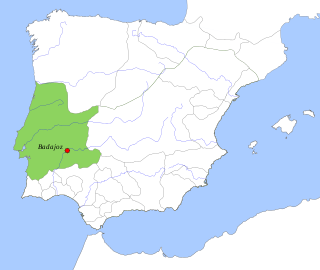
The Reconquista or the reconquest of al-Andalus was the successful series of military campaigns that European Christian kingdoms waged against the Muslim kingdoms following the Muslim conquest of the Iberian Peninsula by the Umayyad Caliphate. The beginning of the Reconquista is traditionally dated to the Battle of Covadonga, in which an Asturian army achieved the first Christian victory over the forces of the Umayyad Caliphate since the beginning of the military invasion. Its culmination came in 1492 with the fall of the Nasrid kingdom of Granada to the Catholic Monarchs.

The Almohad Caliphate or Almohad Empire was a North African Berber Muslim empire founded in the 12th century. At its height, it controlled much of the Iberian Peninsula (Al-Andalus) and North Africa.

Al-Andalus was the Muslim-ruled area of the Iberian Peninsula. The term is used by modern historians for the former Islamic states in modern-day Gibraltar, Portugal, Spain, and Southern France. The name describes the different Muslim states that controlled these territories at various times between 711 and 1492. At its greatest geographical extent, it occupied most of the peninsula and part of present-day southern France (Septimania) under Umayyad rule. These boundaries changed constantly through a series of conquests Western historiography has traditionally characterized as the Reconquista, eventually shrinking to the south and finally to the Emirate of Granada.

The taifas were the independent Muslim principalities and kingdoms of the Iberian Peninsula, referred to by Muslims as al-Andalus, that emerged from the decline and fall of the Umayyad Caliphate of Córdoba between 1009 and 1031. They were a recurring feature of al-Andalus history.
This is a historical timeline of Portugal.
This is a historical timeline of Portugal.
This is a historical timeline of Portugal.

Abu Muhammad ʿAbdallah 'al-ʿAdil' was an Almohad Caliph, a former governor in al-Andalus who challenged and secured the murder of his predecessor, Abd al-Wahid I. His 1224 coup ushered in a period of instability that lasted well beyond his own death in 1227. He is often regarded as one of the most disastrous of Almohad caliphs. His coup divided the Almohads and set in motion the loss of al-Andalus and the eventual collapse of the Almohad state.

Gharb al-Andalus, or just al-Gharb, was the name given by the Muslims of Iberia to the region of southern modern-day Portugal and part of West-central modern day Spain during their rule of the territory, from 711 to 1249. This period started with the fall of the Visigothic kingdom after Tariq ibn-Ziyad's invasion of Iberia and the establishment of the Umayyad control in the territory. The present day Algarve derives its name from this Arabic name. The region had a population of about 500,000 people.

Marvão is a municipality in Portalegre District in Portugal. The population in 2020 was 2,972, in an area of 154.90 km2. The present Mayor is Luís Vitorino, elected by the Social Democratic Party. The municipal holiday is September 8.

The Battle of Sagrajas, also called Zalaca or Zallaqah, was fought between the Almoravid army led by their King Yusuf ibn Tashfin and an army led by the Castilian King Alfonso VI. The Almoravids responded to the call of Jihad by the taifas which commonly fought amongst themselves however they had united to battle the powerful Christian states to the north. The Taifas aided the Almoravids during the battle with troops, favoring the battle for the Muslim side. The battleground was later called az-Zallaqah because of the poor footing caused by the tremendous amount of bloodshed that day, which gave rise to its name in Arabic.

The Taifa of Seville was an Arab kingdom which was ruled by the Abbadid dynasty. It was established in 1023 and lasted until 1091, in what is today southern Spain and Portugal. It gained independence from the Caliphate of Cordoba and it expanded the territory it ruled in the mid-11th century. The emerging power of Castile led Seville to ask military assistance from the Almoravids, who then occupied Seville.

The Taifa of Toledo was an islamic polity (taifa) located in the centre of the Iberian Peninsula in the high middle ages. It was ruled by the Dhulnunids, a Hawwara Berber clan. It emerged after 1018 upon the fracturing of the Caliphate of Córdoba, when the Dhulnunids, already strong in the lands of Santaver, Cuenca, Huete and Uclés, seized control over the city of Toledo, the capital of the Middle March of Al-Andalus. Upon later territorial conquest, the taifa also expanded to the land of Calatrava. It lasted until the Christian conquest of Toledo in 1085.
Abu Yusuf Yaqub ibn Abd al-Haqq was a Marinid ruler of Morocco. He was the fourth son of Marinid founder Abd al-Haqq, and succeeded his brother Abu Yahya in 1258. He died in 1286. He was the son of Abd al-Haqq I and Oum el-Iman bint Ali el-Bethary, a Zenata woman. Some sources add her mother to be known as Oum el Youm and a daughter of a Zenata clan leader of the Tafersit region.

The Taifa of Murcia was an Arab taifa of medieval Al-Andalus, in what is now southern Spain. It became independent as a taifa centered on the Moorish city of Murcia after the fall of the Umayyad Caliphate of Córdoba. The Moorish Taifa of Murcia included Albacete and part of Almería as well.

The Taifa of Badajoz was a medieval Islamic Moorish kingdom located in what is now parts of Portugal and Spain. It was centred on the city of Badajoz which exists today as the first city of Extremadura, in Spain.

The history of Moorish Gibraltar began with the landing of the Muslims in Hispania and the fall of the Visigothic Kingdom of Toledo in 711 and ended with the fall of Gibraltar to Christian hands 751 years later, in 1462, with an interregnum during the early 14th century.

The documented history of Murcia traces back at least to the Middle Ages, after Madinat Mursiya was built by Andalusi Emir Abd al-Rahman II in the 9th century, while it is suggested the city was erected over a previous settlement of Roman origin.

This chronology presents the timeline of the Reconquista, a series of military and political actions taken following the Muslim conquest of the Iberian Peninsula that began in 711. These Crusades began a decade later with dated to the Battle of Covadonga and it ended Its culmination came in 1492 with the Fall of Granada to Isabella I of Castile and Ferdinand II of Aragon. The evolution of the various Iberian kingdoms to the unified kingdoms of Spain and Portugal was key to the conquest of al-Andalus from the Moors.

Portuguese participation in the Reconquista occurred from when the County of Portugal was founded in 868 and continued for 381 years until the last cities still in Muslim control in the Algarve were captured in 1249. Portugal was created during this prolonged process and largely owes its geographic form to it.















